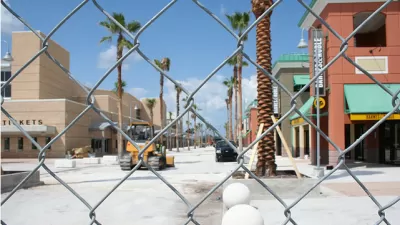After a decade-long construction arms race at the nation's institutions of higher education, The New York Times looks at what happens when the creditors come calling.

While the apartment-style dormitories, lavish recreational centers, and state-of-the-art academic buildings may serve the needs of those college administrators suffering from "Taj Mahal syndrome," the results of a decade-long spending binge on campuses across the country aren't pretty for students, tax payers, or college finances, reports Andrew Martin.
Although America's increasing student loan debt has been a popular topic of conversation, "some colleges and universities have also borrowed heavily, spending money on vast expansions and amenities aimed at luring better students: student unions with movie theaters and wine bars; workout facilities with climbing walls and 'lazy rivers'; and dormitories with single rooms and private baths," says Martin. "Spending on instruction has grown at a much slower pace, studies have shown. Students end up covering some, if not most, of the debt payments in the form of higher tuition, room and board and special assessments, while in some instances state taxpayers pick up the costs."
"With revenue pinched at institutions big and small, financial experts and college officials are sounding alarms about the consequences of the spending and borrowing. Last month, officials warned of 'rapid, disorienting change' at colleges and universities."
FULL STORY: Building a Showcase Campus, Using an I.O.U.

Alabama: Trump Terminates Settlements for Black Communities Harmed By Raw Sewage
Trump deemed the landmark civil rights agreement “illegal DEI and environmental justice policy.”

Study: Maui’s Plan to Convert Vacation Rentals to Long-Term Housing Could Cause Nearly $1 Billion Economic Loss
The plan would reduce visitor accommodation by 25% resulting in 1,900 jobs lost.

Planetizen Federal Action Tracker
A weekly monitor of how Trump’s orders and actions are impacting planners and planning in America.

Waymo Gets Permission to Map SF’s Market Street
If allowed to operate on the traffic-restricted street, Waymo’s autonomous taxis would have a leg up over ride-hailing competitors — and counter the city’s efforts to grow bike and pedestrian on the thoroughfare.

Parklet Symposium Highlights the Success of Shared Spaces
Parklets got a boost during the Covid-19 pandemic, when the concept was translated to outdoor dining programs that offered restaurants a lifeline during the shutdown.

Federal Homelessness Agency Places Entire Staff on Leave
The U.S. Interagency Council on Homelessness is the only federal agency dedicated to preventing and ending homelessness.
Urban Design for Planners 1: Software Tools
This six-course series explores essential urban design concepts using open source software and equips planners with the tools they need to participate fully in the urban design process.
Planning for Universal Design
Learn the tools for implementing Universal Design in planning regulations.
Caltrans
Smith Gee Studio
Institute for Housing and Urban Development Studies (IHS)
City of Grandview
Harvard GSD Executive Education
Toledo-Lucas County Plan Commissions
Salt Lake City
NYU Wagner Graduate School of Public Service





























